Analyzing Eating Habits and Lifestyle Changes During the Pandemic
VerifiedAdded on 2021/06/30
|8
|2563
|136
Essay
AI Summary
This essay explores the multifaceted influences on food tastes, encompassing molecular, physiological, psychological, societal, and educational factors. It discusses how cultural norms significantly shape eating habits, often prioritizing culture over strict dietary needs. The essay then delves into the impact of the COVID-19 pandemic and subsequent lockdowns on eating habits and lifestyle behaviors among UAE residents, revealing shifts towards less healthy nutritional inclinations, reduced physical activity, and increased mental health issues. The study, based on a survey of 1012 participants, highlights a rise in weight gain, decreased water consumption, and increased screen time during the pandemic. It also examines the effects on the restaurant industry, noting the initial decline in dining out followed by a gradual recovery, and explores the growing trend of solo dining, its motivations, and its potential challenges. The conclusion emphasizes the need to address the adverse lifestyle changes and mental health issues resulting from lockdowns, despite their effectiveness in protecting public health.
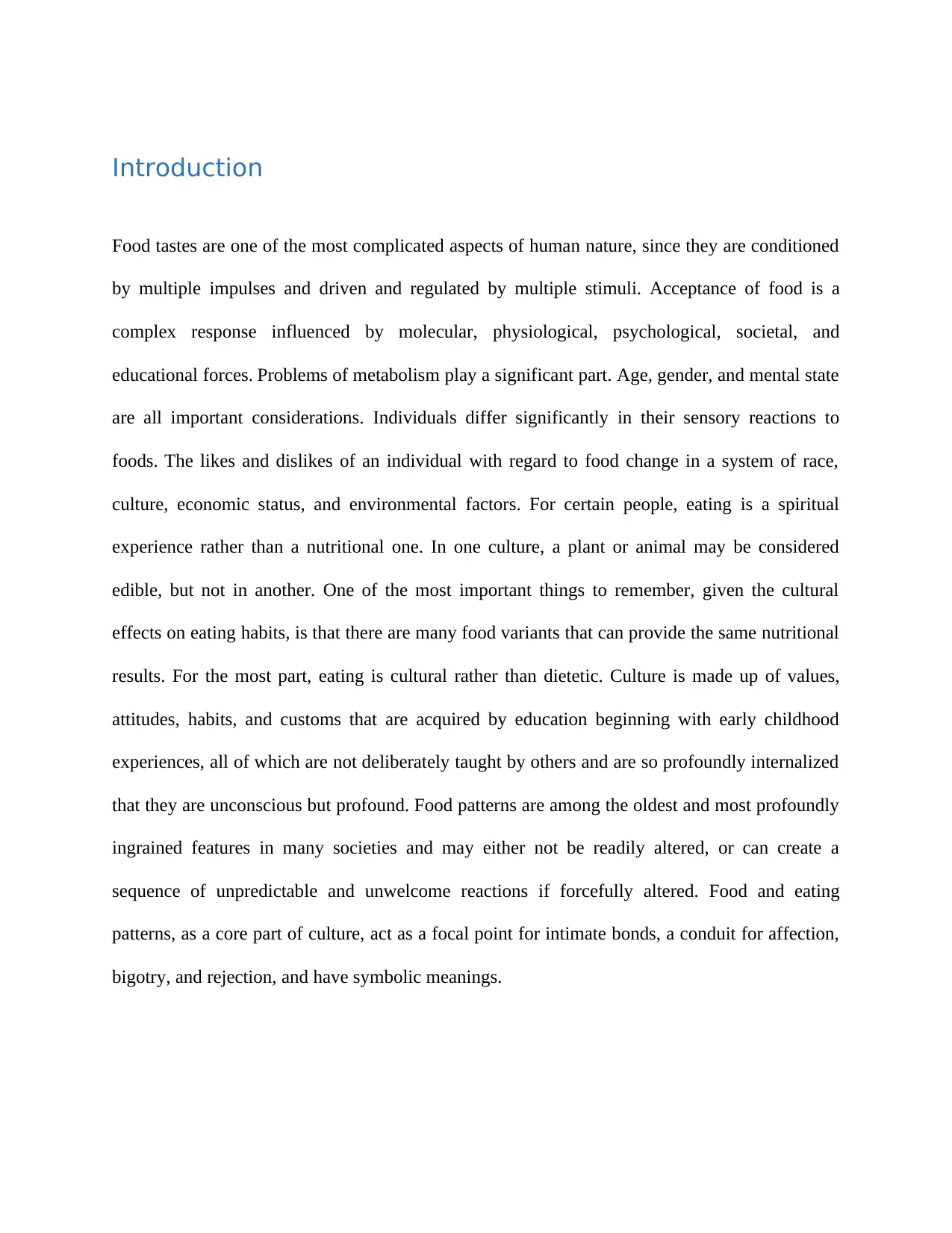
Introduction
Food tastes are one of the most complicated aspects of human nature, since they are conditioned
by multiple impulses and driven and regulated by multiple stimuli. Acceptance of food is a
complex response influenced by molecular, physiological, psychological, societal, and
educational forces. Problems of metabolism play a significant part. Age, gender, and mental state
are all important considerations. Individuals differ significantly in their sensory reactions to
foods. The likes and dislikes of an individual with regard to food change in a system of race,
culture, economic status, and environmental factors. For certain people, eating is a spiritual
experience rather than a nutritional one. In one culture, a plant or animal may be considered
edible, but not in another. One of the most important things to remember, given the cultural
effects on eating habits, is that there are many food variants that can provide the same nutritional
results. For the most part, eating is cultural rather than dietetic. Culture is made up of values,
attitudes, habits, and customs that are acquired by education beginning with early childhood
experiences, all of which are not deliberately taught by others and are so profoundly internalized
that they are unconscious but profound. Food patterns are among the oldest and most profoundly
ingrained features in many societies and may either not be readily altered, or can create a
sequence of unpredictable and unwelcome reactions if forcefully altered. Food and eating
patterns, as a core part of culture, act as a focal point for intimate bonds, a conduit for affection,
bigotry, and rejection, and have symbolic meanings.
Food tastes are one of the most complicated aspects of human nature, since they are conditioned
by multiple impulses and driven and regulated by multiple stimuli. Acceptance of food is a
complex response influenced by molecular, physiological, psychological, societal, and
educational forces. Problems of metabolism play a significant part. Age, gender, and mental state
are all important considerations. Individuals differ significantly in their sensory reactions to
foods. The likes and dislikes of an individual with regard to food change in a system of race,
culture, economic status, and environmental factors. For certain people, eating is a spiritual
experience rather than a nutritional one. In one culture, a plant or animal may be considered
edible, but not in another. One of the most important things to remember, given the cultural
effects on eating habits, is that there are many food variants that can provide the same nutritional
results. For the most part, eating is cultural rather than dietetic. Culture is made up of values,
attitudes, habits, and customs that are acquired by education beginning with early childhood
experiences, all of which are not deliberately taught by others and are so profoundly internalized
that they are unconscious but profound. Food patterns are among the oldest and most profoundly
ingrained features in many societies and may either not be readily altered, or can create a
sequence of unpredictable and unwelcome reactions if forcefully altered. Food and eating
patterns, as a core part of culture, act as a focal point for intimate bonds, a conduit for affection,
bigotry, and rejection, and have symbolic meanings.
Paraphrase This Document
Need a fresh take? Get an instant paraphrase of this document with our AI Paraphraser
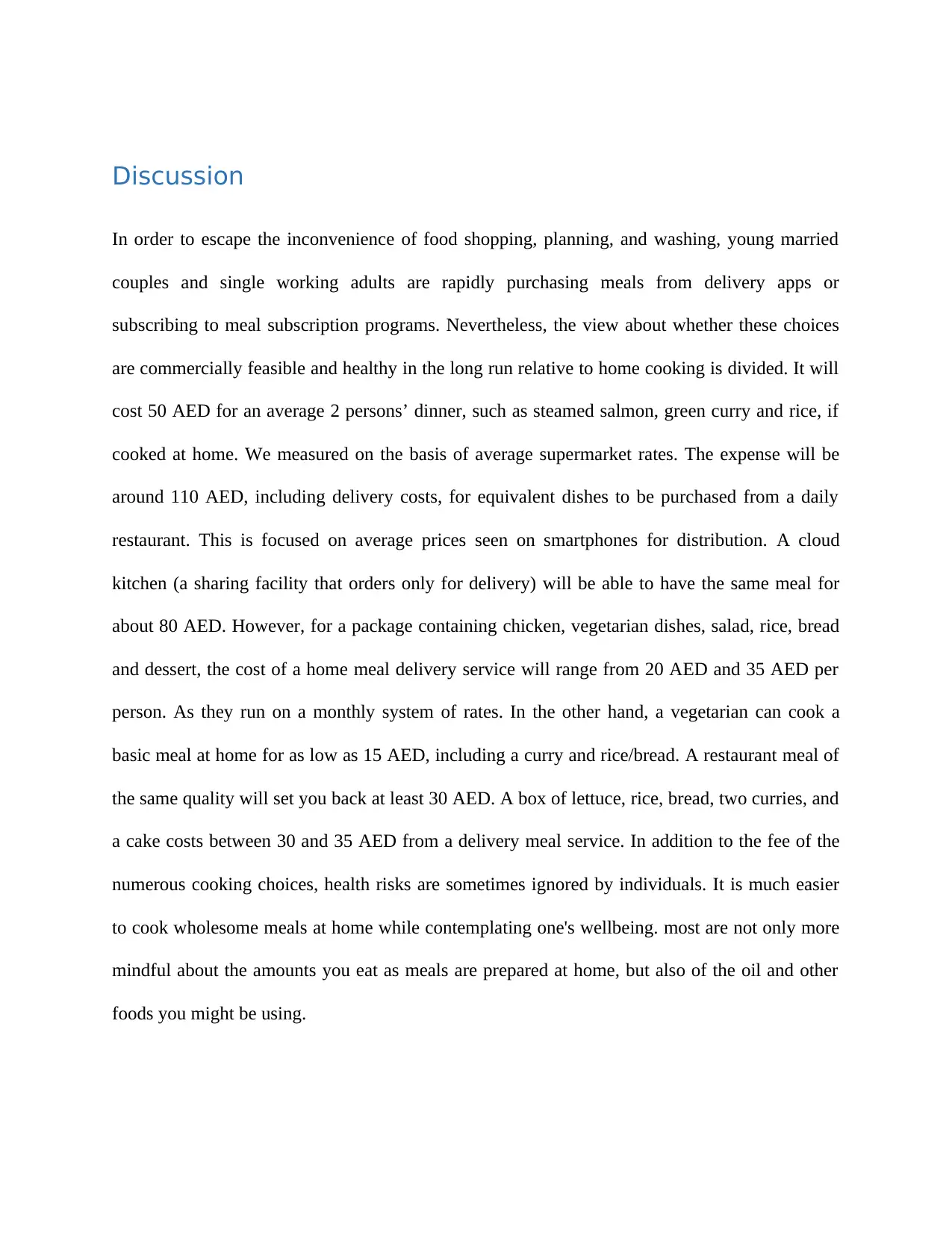
Discussion
In order to escape the inconvenience of food shopping, planning, and washing, young married
couples and single working adults are rapidly purchasing meals from delivery apps or
subscribing to meal subscription programs. Nevertheless, the view about whether these choices
are commercially feasible and healthy in the long run relative to home cooking is divided. It will
cost 50 AED for an average 2 persons’ dinner, such as steamed salmon, green curry and rice, if
cooked at home. We measured on the basis of average supermarket rates. The expense will be
around 110 AED, including delivery costs, for equivalent dishes to be purchased from a daily
restaurant. This is focused on average prices seen on smartphones for distribution. A cloud
kitchen (a sharing facility that orders only for delivery) will be able to have the same meal for
about 80 AED. However, for a package containing chicken, vegetarian dishes, salad, rice, bread
and dessert, the cost of a home meal delivery service will range from 20 AED and 35 AED per
person. As they run on a monthly system of rates. In the other hand, a vegetarian can cook a
basic meal at home for as low as 15 AED, including a curry and rice/bread. A restaurant meal of
the same quality will set you back at least 30 AED. A box of lettuce, rice, bread, two curries, and
a cake costs between 30 and 35 AED from a delivery meal service. In addition to the fee of the
numerous cooking choices, health risks are sometimes ignored by individuals. It is much easier
to cook wholesome meals at home while contemplating one's wellbeing. most are not only more
mindful about the amounts you eat as meals are prepared at home, but also of the oil and other
foods you might be using.
In order to escape the inconvenience of food shopping, planning, and washing, young married
couples and single working adults are rapidly purchasing meals from delivery apps or
subscribing to meal subscription programs. Nevertheless, the view about whether these choices
are commercially feasible and healthy in the long run relative to home cooking is divided. It will
cost 50 AED for an average 2 persons’ dinner, such as steamed salmon, green curry and rice, if
cooked at home. We measured on the basis of average supermarket rates. The expense will be
around 110 AED, including delivery costs, for equivalent dishes to be purchased from a daily
restaurant. This is focused on average prices seen on smartphones for distribution. A cloud
kitchen (a sharing facility that orders only for delivery) will be able to have the same meal for
about 80 AED. However, for a package containing chicken, vegetarian dishes, salad, rice, bread
and dessert, the cost of a home meal delivery service will range from 20 AED and 35 AED per
person. As they run on a monthly system of rates. In the other hand, a vegetarian can cook a
basic meal at home for as low as 15 AED, including a curry and rice/bread. A restaurant meal of
the same quality will set you back at least 30 AED. A box of lettuce, rice, bread, two curries, and
a cake costs between 30 and 35 AED from a delivery meal service. In addition to the fee of the
numerous cooking choices, health risks are sometimes ignored by individuals. It is much easier
to cook wholesome meals at home while contemplating one's wellbeing. most are not only more
mindful about the amounts you eat as meals are prepared at home, but also of the oil and other
foods you might be using.
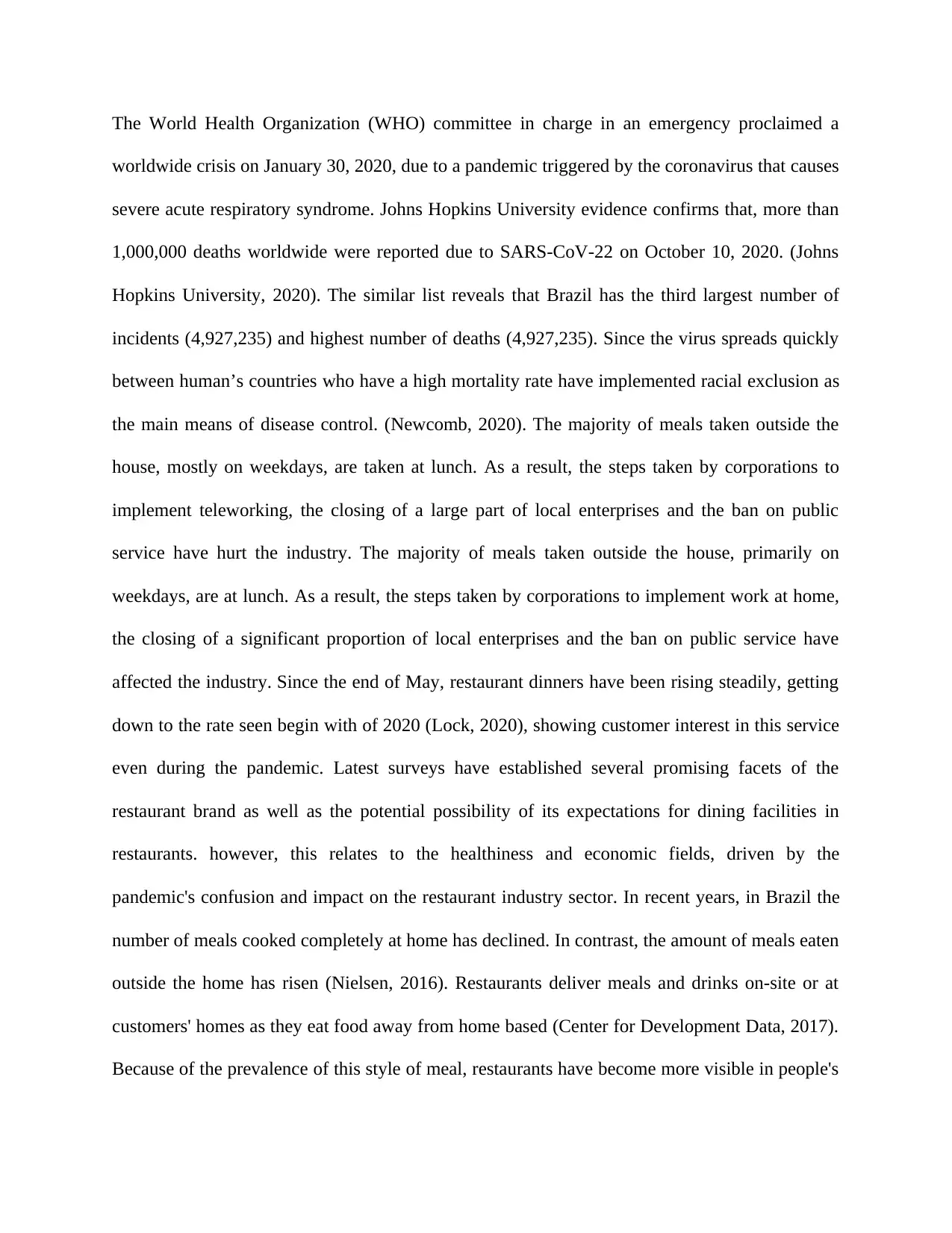
The World Health Organization (WHO) committee in charge in an emergency proclaimed a
worldwide crisis on January 30, 2020, due to a pandemic triggered by the coronavirus that causes
severe acute respiratory syndrome. Johns Hopkins University evidence confirms that, more than
1,000,000 deaths worldwide were reported due to SARS-CoV-22 on October 10, 2020. (Johns
Hopkins University, 2020). The similar list reveals that Brazil has the third largest number of
incidents (4,927,235) and highest number of deaths (4,927,235). Since the virus spreads quickly
between human’s countries who have a high mortality rate have implemented racial exclusion as
the main means of disease control. (Newcomb, 2020). The majority of meals taken outside the
house, mostly on weekdays, are taken at lunch. As a result, the steps taken by corporations to
implement teleworking, the closing of a large part of local enterprises and the ban on public
service have hurt the industry. The majority of meals taken outside the house, primarily on
weekdays, are at lunch. As a result, the steps taken by corporations to implement work at home,
the closing of a significant proportion of local enterprises and the ban on public service have
affected the industry. Since the end of May, restaurant dinners have been rising steadily, getting
down to the rate seen begin with of 2020 (Lock, 2020), showing customer interest in this service
even during the pandemic. Latest surveys have established several promising facets of the
restaurant brand as well as the potential possibility of its expectations for dining facilities in
restaurants. however, this relates to the healthiness and economic fields, driven by the
pandemic's confusion and impact on the restaurant industry sector. In recent years, in Brazil the
number of meals cooked completely at home has declined. In contrast, the amount of meals eaten
outside the home has risen (Nielsen, 2016). Restaurants deliver meals and drinks on-site or at
customers' homes as they eat food away from home based (Center for Development Data, 2017).
Because of the prevalence of this style of meal, restaurants have become more visible in people's
worldwide crisis on January 30, 2020, due to a pandemic triggered by the coronavirus that causes
severe acute respiratory syndrome. Johns Hopkins University evidence confirms that, more than
1,000,000 deaths worldwide were reported due to SARS-CoV-22 on October 10, 2020. (Johns
Hopkins University, 2020). The similar list reveals that Brazil has the third largest number of
incidents (4,927,235) and highest number of deaths (4,927,235). Since the virus spreads quickly
between human’s countries who have a high mortality rate have implemented racial exclusion as
the main means of disease control. (Newcomb, 2020). The majority of meals taken outside the
house, mostly on weekdays, are taken at lunch. As a result, the steps taken by corporations to
implement teleworking, the closing of a large part of local enterprises and the ban on public
service have hurt the industry. The majority of meals taken outside the house, primarily on
weekdays, are at lunch. As a result, the steps taken by corporations to implement work at home,
the closing of a significant proportion of local enterprises and the ban on public service have
affected the industry. Since the end of May, restaurant dinners have been rising steadily, getting
down to the rate seen begin with of 2020 (Lock, 2020), showing customer interest in this service
even during the pandemic. Latest surveys have established several promising facets of the
restaurant brand as well as the potential possibility of its expectations for dining facilities in
restaurants. however, this relates to the healthiness and economic fields, driven by the
pandemic's confusion and impact on the restaurant industry sector. In recent years, in Brazil the
number of meals cooked completely at home has declined. In contrast, the amount of meals eaten
outside the home has risen (Nielsen, 2016). Restaurants deliver meals and drinks on-site or at
customers' homes as they eat food away from home based (Center for Development Data, 2017).
Because of the prevalence of this style of meal, restaurants have become more visible in people's
⊘ This is a preview!⊘
Do you want full access?
Subscribe today to unlock all pages.

Trusted by 1+ million students worldwide
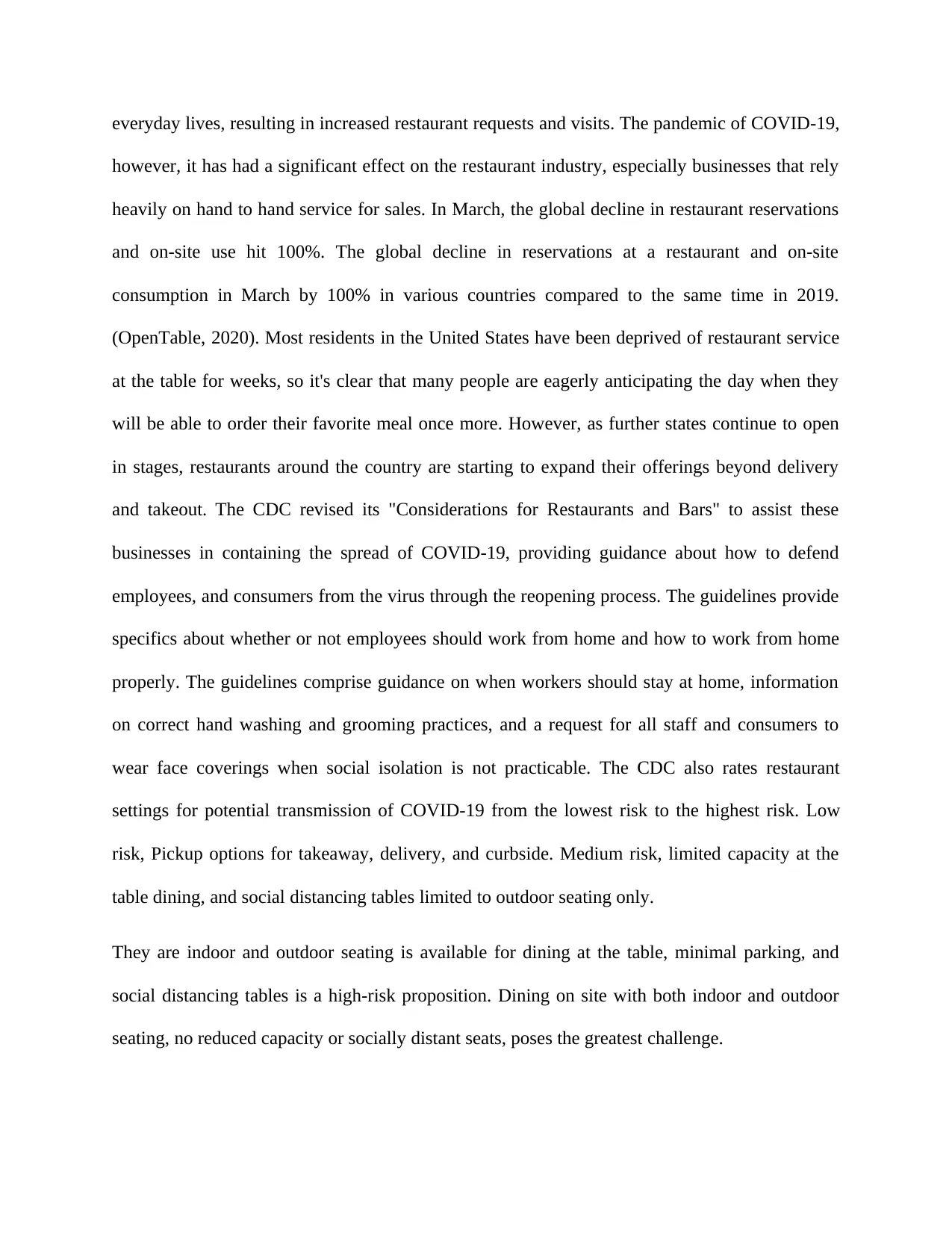
everyday lives, resulting in increased restaurant requests and visits. The pandemic of COVID-19,
however, it has had a significant effect on the restaurant industry, especially businesses that rely
heavily on hand to hand service for sales. In March, the global decline in restaurant reservations
and on-site use hit 100%. The global decline in reservations at a restaurant and on-site
consumption in March by 100% in various countries compared to the same time in 2019.
(OpenTable, 2020). Most residents in the United States have been deprived of restaurant service
at the table for weeks, so it's clear that many people are eagerly anticipating the day when they
will be able to order their favorite meal once more. However, as further states continue to open
in stages, restaurants around the country are starting to expand their offerings beyond delivery
and takeout. The CDC revised its "Considerations for Restaurants and Bars" to assist these
businesses in containing the spread of COVID-19, providing guidance about how to defend
employees, and consumers from the virus through the reopening process. The guidelines provide
specifics about whether or not employees should work from home and how to work from home
properly. The guidelines comprise guidance on when workers should stay at home, information
on correct hand washing and grooming practices, and a request for all staff and consumers to
wear face coverings when social isolation is not practicable. The CDC also rates restaurant
settings for potential transmission of COVID-19 from the lowest risk to the highest risk. Low
risk, Pickup options for takeaway, delivery, and curbside. Medium risk, limited capacity at the
table dining, and social distancing tables limited to outdoor seating only.
They are indoor and outdoor seating is available for dining at the table, minimal parking, and
social distancing tables is a high-risk proposition. Dining on site with both indoor and outdoor
seating, no reduced capacity or socially distant seats, poses the greatest challenge.
however, it has had a significant effect on the restaurant industry, especially businesses that rely
heavily on hand to hand service for sales. In March, the global decline in restaurant reservations
and on-site use hit 100%. The global decline in reservations at a restaurant and on-site
consumption in March by 100% in various countries compared to the same time in 2019.
(OpenTable, 2020). Most residents in the United States have been deprived of restaurant service
at the table for weeks, so it's clear that many people are eagerly anticipating the day when they
will be able to order their favorite meal once more. However, as further states continue to open
in stages, restaurants around the country are starting to expand their offerings beyond delivery
and takeout. The CDC revised its "Considerations for Restaurants and Bars" to assist these
businesses in containing the spread of COVID-19, providing guidance about how to defend
employees, and consumers from the virus through the reopening process. The guidelines provide
specifics about whether or not employees should work from home and how to work from home
properly. The guidelines comprise guidance on when workers should stay at home, information
on correct hand washing and grooming practices, and a request for all staff and consumers to
wear face coverings when social isolation is not practicable. The CDC also rates restaurant
settings for potential transmission of COVID-19 from the lowest risk to the highest risk. Low
risk, Pickup options for takeaway, delivery, and curbside. Medium risk, limited capacity at the
table dining, and social distancing tables limited to outdoor seating only.
They are indoor and outdoor seating is available for dining at the table, minimal parking, and
social distancing tables is a high-risk proposition. Dining on site with both indoor and outdoor
seating, no reduced capacity or socially distant seats, poses the greatest challenge.
Paraphrase This Document
Need a fresh take? Get an instant paraphrase of this document with our AI Paraphraser
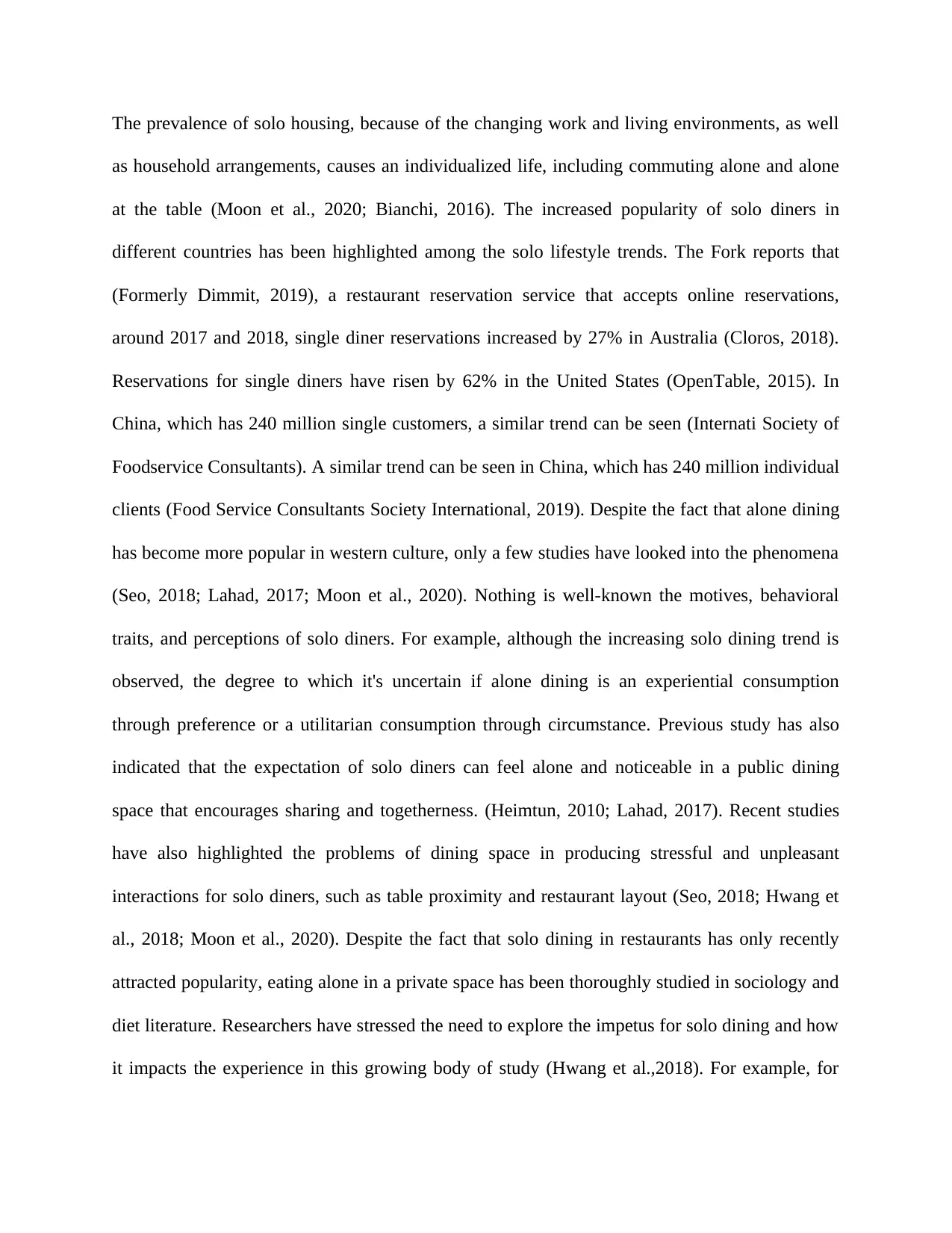
The prevalence of solo housing, because of the changing work and living environments, as well
as household arrangements, causes an individualized life, including commuting alone and alone
at the table (Moon et al., 2020; Bianchi, 2016). The increased popularity of solo diners in
different countries has been highlighted among the solo lifestyle trends. The Fork reports that
(Formerly Dimmit, 2019), a restaurant reservation service that accepts online reservations,
around 2017 and 2018, single diner reservations increased by 27% in Australia (Cloros, 2018).
Reservations for single diners have risen by 62% in the United States (OpenTable, 2015). In
China, which has 240 million single customers, a similar trend can be seen (Internati Society of
Foodservice Consultants). A similar trend can be seen in China, which has 240 million individual
clients (Food Service Consultants Society International, 2019). Despite the fact that alone dining
has become more popular in western culture, only a few studies have looked into the phenomena
(Seo, 2018; Lahad, 2017; Moon et al., 2020). Nothing is well-known the motives, behavioral
traits, and perceptions of solo diners. For example, although the increasing solo dining trend is
observed, the degree to which it's uncertain if alone dining is an experiential consumption
through preference or a utilitarian consumption through circumstance. Previous study has also
indicated that the expectation of solo diners can feel alone and noticeable in a public dining
space that encourages sharing and togetherness. (Heimtun, 2010; Lahad, 2017). Recent studies
have also highlighted the problems of dining space in producing stressful and unpleasant
interactions for solo diners, such as table proximity and restaurant layout (Seo, 2018; Hwang et
al., 2018; Moon et al., 2020). Despite the fact that solo dining in restaurants has only recently
attracted popularity, eating alone in a private space has been thoroughly studied in sociology and
diet literature. Researchers have stressed the need to explore the impetus for solo dining and how
it impacts the experience in this growing body of study (Hwang et al.,2018). For example, for
as household arrangements, causes an individualized life, including commuting alone and alone
at the table (Moon et al., 2020; Bianchi, 2016). The increased popularity of solo diners in
different countries has been highlighted among the solo lifestyle trends. The Fork reports that
(Formerly Dimmit, 2019), a restaurant reservation service that accepts online reservations,
around 2017 and 2018, single diner reservations increased by 27% in Australia (Cloros, 2018).
Reservations for single diners have risen by 62% in the United States (OpenTable, 2015). In
China, which has 240 million single customers, a similar trend can be seen (Internati Society of
Foodservice Consultants). A similar trend can be seen in China, which has 240 million individual
clients (Food Service Consultants Society International, 2019). Despite the fact that alone dining
has become more popular in western culture, only a few studies have looked into the phenomena
(Seo, 2018; Lahad, 2017; Moon et al., 2020). Nothing is well-known the motives, behavioral
traits, and perceptions of solo diners. For example, although the increasing solo dining trend is
observed, the degree to which it's uncertain if alone dining is an experiential consumption
through preference or a utilitarian consumption through circumstance. Previous study has also
indicated that the expectation of solo diners can feel alone and noticeable in a public dining
space that encourages sharing and togetherness. (Heimtun, 2010; Lahad, 2017). Recent studies
have also highlighted the problems of dining space in producing stressful and unpleasant
interactions for solo diners, such as table proximity and restaurant layout (Seo, 2018; Hwang et
al., 2018; Moon et al., 2020). Despite the fact that solo dining in restaurants has only recently
attracted popularity, eating alone in a private space has been thoroughly studied in sociology and
diet literature. Researchers have stressed the need to explore the impetus for solo dining and how
it impacts the experience in this growing body of study (Hwang et al.,2018). For example, for
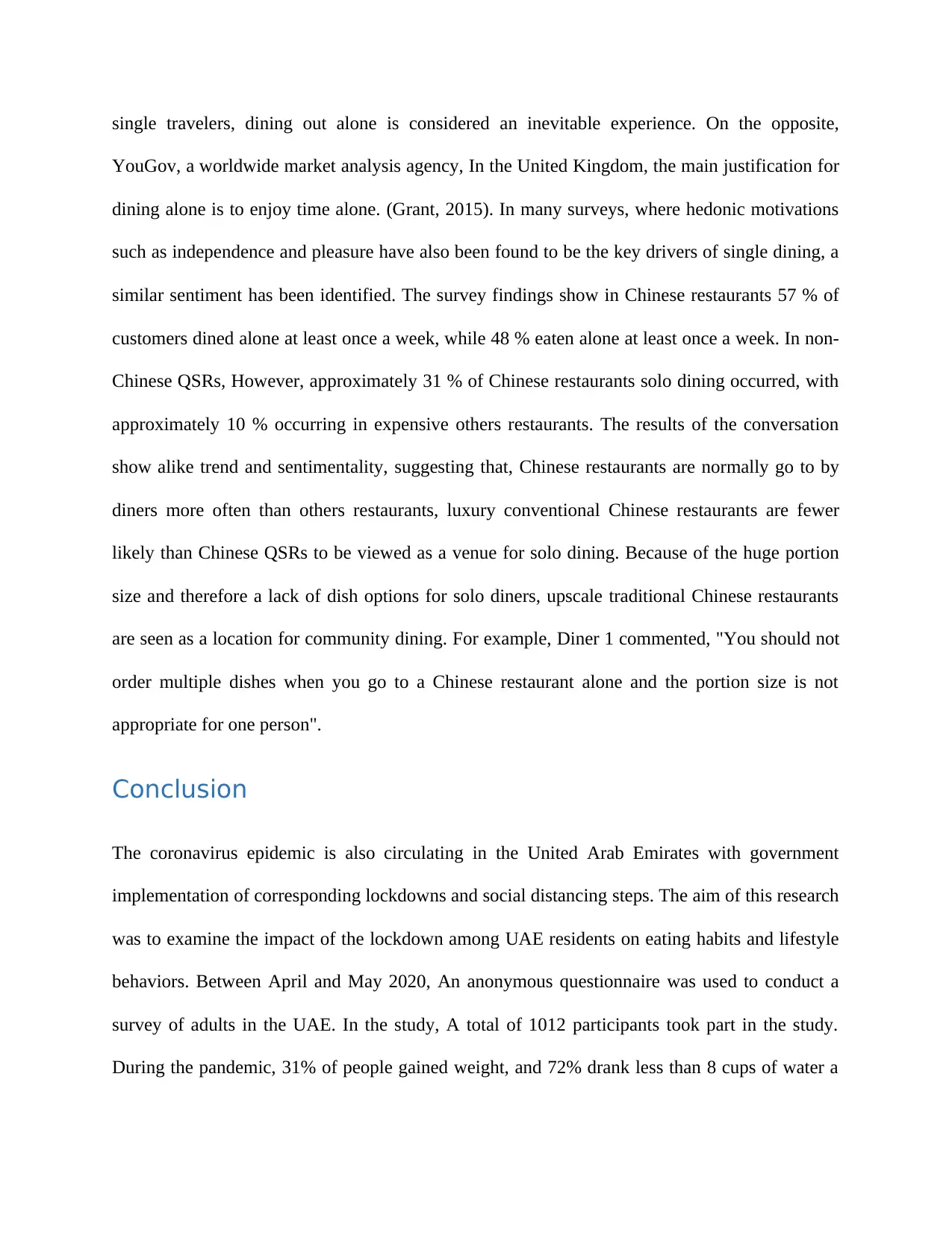
single travelers, dining out alone is considered an inevitable experience. On the opposite,
YouGov, a worldwide market analysis agency, In the United Kingdom, the main justification for
dining alone is to enjoy time alone. (Grant, 2015). In many surveys, where hedonic motivations
such as independence and pleasure have also been found to be the key drivers of single dining, a
similar sentiment has been identified. The survey findings show in Chinese restaurants 57 % of
customers dined alone at least once a week, while 48 % eaten alone at least once a week. In non-
Chinese QSRs, However, approximately 31 % of Chinese restaurants solo dining occurred, with
approximately 10 % occurring in expensive others restaurants. The results of the conversation
show alike trend and sentimentality, suggesting that, Chinese restaurants are normally go to by
diners more often than others restaurants, luxury conventional Chinese restaurants are fewer
likely than Chinese QSRs to be viewed as a venue for solo dining. Because of the huge portion
size and therefore a lack of dish options for solo diners, upscale traditional Chinese restaurants
are seen as a location for community dining. For example, Diner 1 commented, "You should not
order multiple dishes when you go to a Chinese restaurant alone and the portion size is not
appropriate for one person".
Conclusion
The coronavirus epidemic is also circulating in the United Arab Emirates with government
implementation of corresponding lockdowns and social distancing steps. The aim of this research
was to examine the impact of the lockdown among UAE residents on eating habits and lifestyle
behaviors. Between April and May 2020, An anonymous questionnaire was used to conduct a
survey of adults in the UAE. In the study, A total of 1012 participants took part in the study.
During the pandemic, 31% of people gained weight, and 72% drank less than 8 cups of water a
YouGov, a worldwide market analysis agency, In the United Kingdom, the main justification for
dining alone is to enjoy time alone. (Grant, 2015). In many surveys, where hedonic motivations
such as independence and pleasure have also been found to be the key drivers of single dining, a
similar sentiment has been identified. The survey findings show in Chinese restaurants 57 % of
customers dined alone at least once a week, while 48 % eaten alone at least once a week. In non-
Chinese QSRs, However, approximately 31 % of Chinese restaurants solo dining occurred, with
approximately 10 % occurring in expensive others restaurants. The results of the conversation
show alike trend and sentimentality, suggesting that, Chinese restaurants are normally go to by
diners more often than others restaurants, luxury conventional Chinese restaurants are fewer
likely than Chinese QSRs to be viewed as a venue for solo dining. Because of the huge portion
size and therefore a lack of dish options for solo diners, upscale traditional Chinese restaurants
are seen as a location for community dining. For example, Diner 1 commented, "You should not
order multiple dishes when you go to a Chinese restaurant alone and the portion size is not
appropriate for one person".
Conclusion
The coronavirus epidemic is also circulating in the United Arab Emirates with government
implementation of corresponding lockdowns and social distancing steps. The aim of this research
was to examine the impact of the lockdown among UAE residents on eating habits and lifestyle
behaviors. Between April and May 2020, An anonymous questionnaire was used to conduct a
survey of adults in the UAE. In the study, A total of 1012 participants took part in the study.
During the pandemic, 31% of people gained weight, and 72% drank less than 8 cups of water a
⊘ This is a preview!⊘
Do you want full access?
Subscribe today to unlock all pages.

Trusted by 1+ million students worldwide
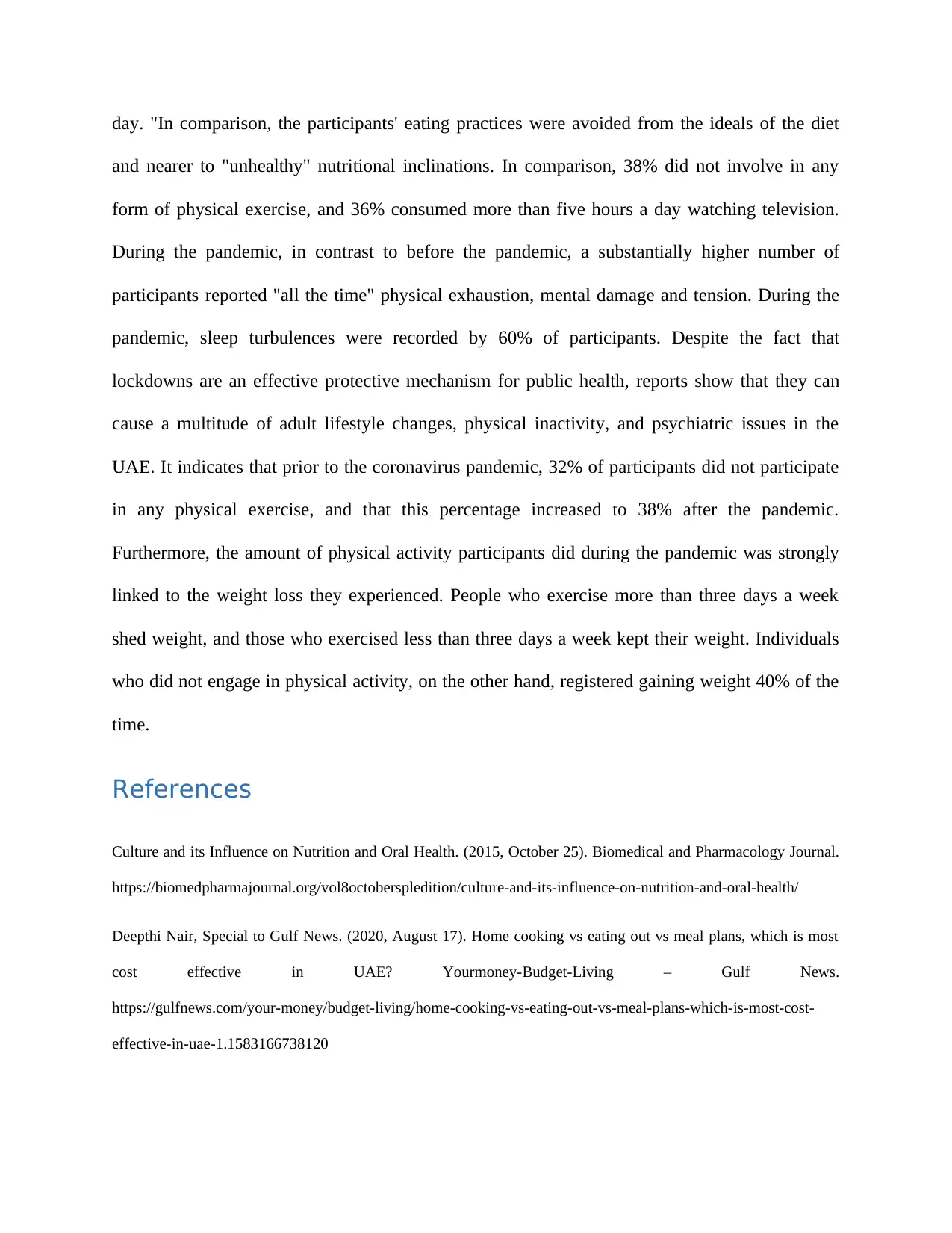
day. "In comparison, the participants' eating practices were avoided from the ideals of the diet
and nearer to "unhealthy" nutritional inclinations. In comparison, 38% did not involve in any
form of physical exercise, and 36% consumed more than five hours a day watching television.
During the pandemic, in contrast to before the pandemic, a substantially higher number of
participants reported "all the time" physical exhaustion, mental damage and tension. During the
pandemic, sleep turbulences were recorded by 60% of participants. Despite the fact that
lockdowns are an effective protective mechanism for public health, reports show that they can
cause a multitude of adult lifestyle changes, physical inactivity, and psychiatric issues in the
UAE. It indicates that prior to the coronavirus pandemic, 32% of participants did not participate
in any physical exercise, and that this percentage increased to 38% after the pandemic.
Furthermore, the amount of physical activity participants did during the pandemic was strongly
linked to the weight loss they experienced. People who exercise more than three days a week
shed weight, and those who exercised less than three days a week kept their weight. Individuals
who did not engage in physical activity, on the other hand, registered gaining weight 40% of the
time.
References
Culture and its Influence on Nutrition and Oral Health. (2015, October 25). Biomedical and Pharmacology Journal.
https://biomedpharmajournal.org/vol8octoberspledition/culture-and-its-influence-on-nutrition-and-oral-health/
Deepthi Nair, Special to Gulf News. (2020, August 17). Home cooking vs eating out vs meal plans, which is most
cost effective in UAE? Yourmoney-Budget-Living – Gulf News.
https://gulfnews.com/your-money/budget-living/home-cooking-vs-eating-out-vs-meal-plans-which-is-most-cost-
effective-in-uae-1.1583166738120
and nearer to "unhealthy" nutritional inclinations. In comparison, 38% did not involve in any
form of physical exercise, and 36% consumed more than five hours a day watching television.
During the pandemic, in contrast to before the pandemic, a substantially higher number of
participants reported "all the time" physical exhaustion, mental damage and tension. During the
pandemic, sleep turbulences were recorded by 60% of participants. Despite the fact that
lockdowns are an effective protective mechanism for public health, reports show that they can
cause a multitude of adult lifestyle changes, physical inactivity, and psychiatric issues in the
UAE. It indicates that prior to the coronavirus pandemic, 32% of participants did not participate
in any physical exercise, and that this percentage increased to 38% after the pandemic.
Furthermore, the amount of physical activity participants did during the pandemic was strongly
linked to the weight loss they experienced. People who exercise more than three days a week
shed weight, and those who exercised less than three days a week kept their weight. Individuals
who did not engage in physical activity, on the other hand, registered gaining weight 40% of the
time.
References
Culture and its Influence on Nutrition and Oral Health. (2015, October 25). Biomedical and Pharmacology Journal.
https://biomedpharmajournal.org/vol8octoberspledition/culture-and-its-influence-on-nutrition-and-oral-health/
Deepthi Nair, Special to Gulf News. (2020, August 17). Home cooking vs eating out vs meal plans, which is most
cost effective in UAE? Yourmoney-Budget-Living – Gulf News.
https://gulfnews.com/your-money/budget-living/home-cooking-vs-eating-out-vs-meal-plans-which-is-most-cost-
effective-in-uae-1.1583166738120
Paraphrase This Document
Need a fresh take? Get an instant paraphrase of this document with our AI Paraphraser
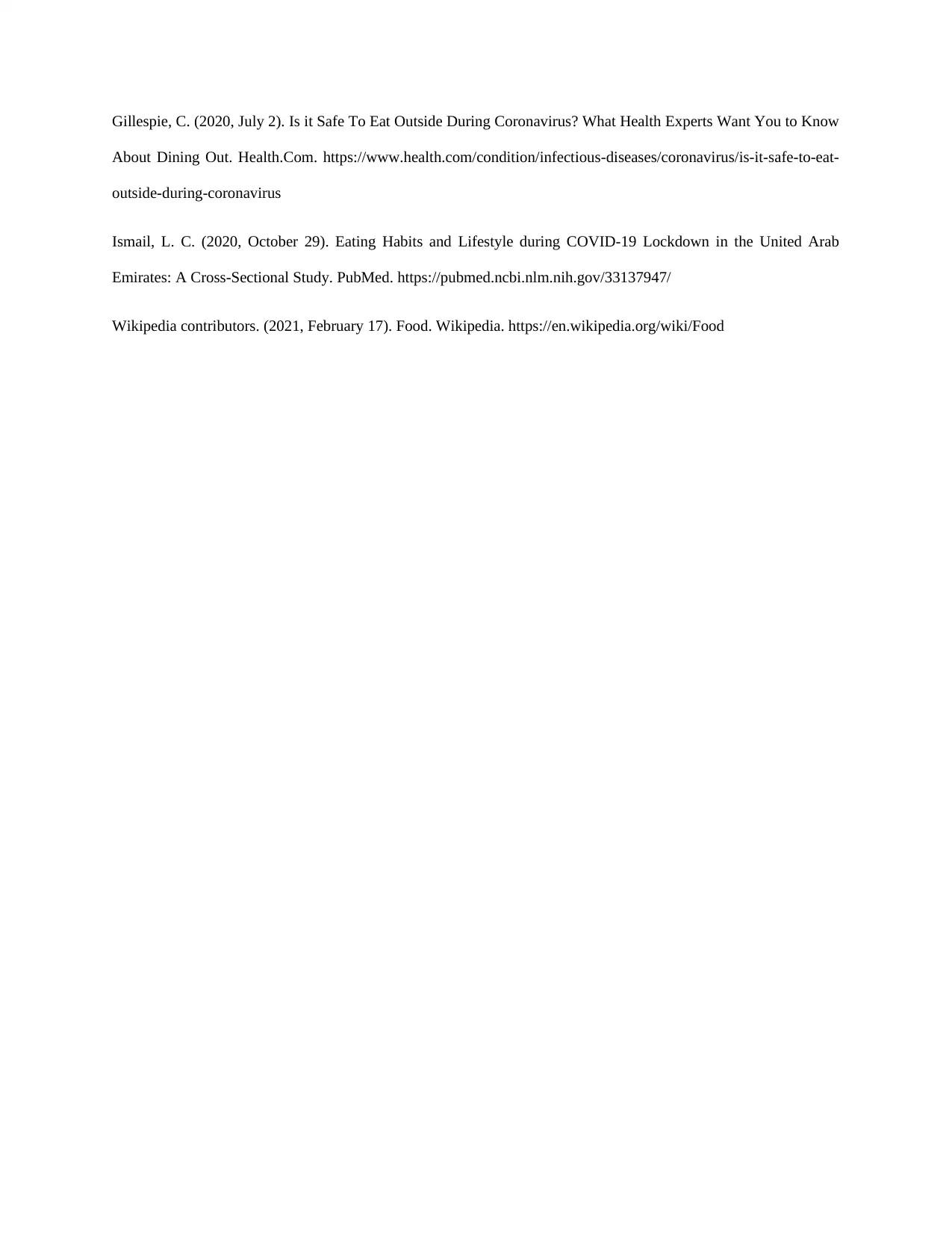
Gillespie, C. (2020, July 2). Is it Safe To Eat Outside During Coronavirus? What Health Experts Want You to Know
About Dining Out. Health.Com. https://www.health.com/condition/infectious-diseases/coronavirus/is-it-safe-to-eat-
outside-during-coronavirus
Ismail, L. C. (2020, October 29). Eating Habits and Lifestyle during COVID-19 Lockdown in the United Arab
Emirates: A Cross-Sectional Study. PubMed. https://pubmed.ncbi.nlm.nih.gov/33137947/
Wikipedia contributors. (2021, February 17). Food. Wikipedia. https://en.wikipedia.org/wiki/Food
About Dining Out. Health.Com. https://www.health.com/condition/infectious-diseases/coronavirus/is-it-safe-to-eat-
outside-during-coronavirus
Ismail, L. C. (2020, October 29). Eating Habits and Lifestyle during COVID-19 Lockdown in the United Arab
Emirates: A Cross-Sectional Study. PubMed. https://pubmed.ncbi.nlm.nih.gov/33137947/
Wikipedia contributors. (2021, February 17). Food. Wikipedia. https://en.wikipedia.org/wiki/Food
1 out of 8
Your All-in-One AI-Powered Toolkit for Academic Success.
+13062052269
info@desklib.com
Available 24*7 on WhatsApp / Email
![[object Object]](/_next/static/media/star-bottom.7253800d.svg)
Unlock your academic potential
Copyright © 2020–2025 A2Z Services. All Rights Reserved. Developed and managed by ZUCOL.

